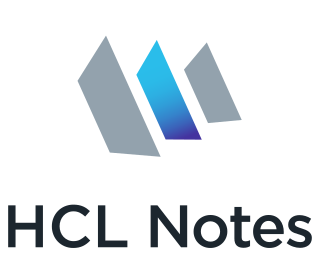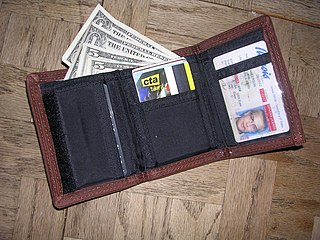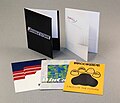Electronic data interchange (EDI) is the concept of businesses electronically communicating information that was traditionally communicated on paper, such as purchase orders, advance ship notices, and invoices. Technical standards for EDI exist to facilitate parties transacting such instruments without having to make special arrangements.

HCL Notes is a proprietary collaborative software platform for Unix (AIX), IBM i, Windows, Linux, and macOS, sold by HCLTech. The client application is called Notes while the server component is branded HCL Domino.

An MFP, multi-functional, all-in-one (AIO), or multi-function device (MFD), is an office machine which incorporates the functionality of multiple devices in one, so as to have a smaller footprint in a home or small business setting, or to provide centralized document management/distribution/production in a large-office setting. A typical MFP may act as a combination of some or all of the following devices: email, fax, photocopier, printer, scanner.

Stationery refers to writing materials, including cut paper, envelopes, continuous form paper, and other office supplies. Stationery usually specifies materials to be written on by hand or by equipment such as computer printers.
A white paper is a report or guide that informs readers concisely about a complex issue and presents the issuing body's philosophy on the matter. It is meant to help readers understand an issue, solve a problem, or make a decision. Since the 1990s, this type of document has proliferated in business. Today, a business-to-business (B2B) white paper is closer to a marketing presentation, a form of content meant to persuade customers and partners and promote a certain product or viewpoint. That makes B2B white papers a type of grey literature.
Accounts payable (AP) is money owed by a business to its suppliers shown as a liability on a company's balance sheet. It is distinct from notes payable liabilities, which are debts created by formal legal instrument documents. An accounts payable department's main responsibility is to process and review transactions between the company and its suppliers and to make sure that all outstanding invoices from their suppliers are approved, processed, and paid. The accounts payable process starts with collecting supply requirements from within the organization and seeking quotes from vendors for the items required. Once the deal is negotiated, purchase orders are prepared and sent. The goods delivered are inspected upon arrival and the invoice received is routed for approvals. Processing an invoice includes recording important data from the invoice and inputting it into the company's financial, or bookkeeping, system. After this is accomplished, the invoices must go through the company's respective business process in order to be paid.

A wallet is a flat case or pouch, often used to carry small personal items such as physical currency, debit cards, and credit cards; identification documents such as driving licence, identification card, club card; photographs, transit pass, business cards and other paper or laminated cards. Wallets are generally made of fabric or leather, and they are usually pocket-sized and foldable.
Marketing communications refers to the use of different marketing channels and tools in combination. Marketing communication channels focus on how businesses communicate a message to their desired market, or the market in general. It is also in charge of the internal communications of the organization. Marketing communication tools include advertising, personal selling, direct marketing, sponsorship, communication, public relations, social media, customer journey and promotion.
Records management, also known as records and information management, is an organizational function devoted to the management of information in an organization throughout its life cycle, from the time of creation or receipt to its eventual disposition. This includes identifying, classifying, storing, securing, retrieving, tracking and destroying or permanently preserving records. The ISO 15489-1: 2001 standard defines records management as "[the] field of management responsible for the efficient and systematic control of the creation, receipt, maintenance, use and disposition of records, including the processes for capturing and maintaining evidence of and information about business activities and transactions in the form of records".
Enterprise content management (ECM) extends the concept of content management by adding a timeline for each content item and, possibly, enforcing processes for its creation, approval, and distribution. Systems using ECM generally provide a secure repository for managed items, analog or digital. They also include one methods for importing content to manage new items, and several presentation methods to make items available for use. Although ECM content may be protected by digital rights management (DRM), it is not required. ECM is distinguished from general content management by its cognizance of the processes and procedures of the enterprise for which it is created.

A folding machine is a machine used primarily for the folding of paper. Folding is the sharp-edged bending of paper webs or sheets under pressure at a prepared or unprepared bending point along a straight line according to specified dimensions and folding layouts. Paper can be folded with either a buckle or a knife; thus, there are generally three types of folding machines: buckle folders, knife folders or a combination of these two types. Whilst buckle folding is the more popular of the two methods, knife folding is sometimes preferable. Folding machine models vary in sophistication, with high-end machines capable of processing more complex folding jobs and unusual paper forms. Organizations required to undertake mass mail-out campaigns often employ folding machines to improve efficiency. However it is very commonly used finishing process across the printing industry.

A file folder is a kind of folder that holds papers together for organization and protection. File folders usually consist of a sheet of heavy paper stock or other thin, but stiff, material which is folded in half, and are used to keep paper documents. They are often used in conjunction with a filing cabinet for storage. File folders can easily be purchased at office supplies stores.

A brochure is a promotional document primarily used to introduce a company, organization, products, or services and inform prospective customers or members of the public of the benefits. Although, initially, a paper document that can be folded into a template, pamphlet, or leaflet, a brochure can also be a set of related unfolded papers put into a pocket folder or packet or can be in digital format.
Corporate communication(s) is a set of activities involved in managing and orchestrating all internal and external communications aimed at creating a favourable point of view among stakeholders on which a company depends. It is the messages issued by a corporate organization, body or institute to its audiences, such as employees, media, channel partners and the general public. Organizations aim to communicate the same message to all its stakeholders, to transmit coherence, credibility and ethics.
Document capture software refers to applications that provide the ability and feature set to automate the process of scanning paper documents or importing electronic documents, often for the purposes of feeding advanced document classification and data collection processes. Most scanning hardware, both scanners and copiers, provides the basic ability to scan to any number of image file formats, including: PDF, TIFF, JPG, BMP, etc. This basic functionality is augmented by document capture software, which can add efficiency and standardization to the process.

Promotional merchandise are products branded with a logo or slogan and distributed at little or no cost to promote a brand, corporate identity, or event. Such products, which are often informally called promo products, swag, or freebies, are used in marketing and sales. Often they are of the tchotchke type. They are given away or sold at a loss to promote a company, corporate image, brand, or event. They are often distributed as handouts at trade shows, at conferences, on sales calls, and as bonus items in shipped orders. They are often used in guerrilla marketing campaigns. Ones for video games are often called feelies.
Discoverability is the degree to which something, especially a piece of content or information, can be found in a search of a file, database, or other information system. Discoverability is a concern in library and information science, many aspects of digital media, software and web development, and in marketing, since products and services cannot be used if people cannot find it or do not understand what it can be used for.

Cardboard is a generic term for heavy paper-based products. The construction can range from a thick paper known as paperboard to corrugated fiberboard which is made of multiple plies of material. Natural cardboards can range from grey to light brown in color, depending on the specific product; dyes, pigments, printing, and coatings are available.
Sustainable distribution refers to any means of transportation / hauling of goods between vendor and purchaser with lowest possible impact on the ecological and social environment, and includes the whole distribution process from storage, order processing and picking, packaging, improved vehicle loadings, delivery to the customer or purchaser and taking back packaging.
The newspaper production process begins with gathering news stories, articles, opinions, advertorials and advertisements to printing and folding of the hard copy. Usually, the news items are printed onto newsprint. The whole production process can be divided into four parts: Content gathering, Pre-press, Press and Post-press. The term production process should not be confused with manufacture as Production process is the stage at which many taxes are levied and collected in almost all countries. Manufacture is the stage at which the product becomes marketable and therefore the term also includes the stages of packaging and packing.












